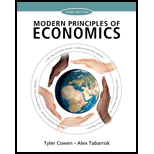
Subpart (a):
How
Subpart (a):
Explanation of Solution
The market is a structure where there are buyers and sellers who sell and the exchange of goods and services between the buyers and sellers exchanges goods and services. The
The Monopoly is a market structure where there is only one seller selling the unique product and the seller faces the downward sloping demand curve. The competitive market is a structure where there are many sellers selling the identical goods in the market and thus the demand curve is a horizontal straight line.
When the case of the monopolistic competition is considered, there are many sellers in the market which makes competition and the feature just like the
Concept introduction:
Market: The market is a structure where there are buyers and sellers who sell and the exchange of goods and services between the buyers and sellers exchanges goods and services.
Monopolistic competition: The monopolistic competition is the market structure where there are many sellers selling differentiated commodities and there are few barriers to entry.
Monopoly: The Monopoly is a market structure where there is only one seller selling the commodity. There will be very strong barriers to entry into the market.
Subpart (b):
How monopolistic competition likes a monopoly and a competition.
Subpart (b):
Explanation of Solution
The demand curve of the monopolist is downward sloping and thus, under the monopoly market structure, the monopolist charges a price which is higher than the marginal cost of producing the commodity. Similarly, in the case of the monopolistic competition, the seller faces the downward sloping demand curve and thus, the monopolistically competitive firm also charges a price which is higher than the marginal cost of producing the commodity which is a direct outcome of the monopoly like feature in the monopolistically competitive firm.
In the perfect competition, the firm earns normal or the zero economic profit in the long run because, the profit would attract more entrants into the market which will increase the supply and reduce the price to the normal level. So, just like this feature of the perfect competition, the monopolistically competitive firm also earns zero economic profit in the long run because there are only a few barriers to entry into the market and the profit attracts more players into the monopolistically competitive market which brings down the
Concept introduction:
Market: The market is a structure where there are buyers and sellers who sell and the exchange of goods and services between the buyers and sellers exchanges goods and services.
Monopolistic competition: The monopolistic competition is the market structure where there are many sellers selling differentiated commodities and there are few barriers to entry.
Monopoly: The Monopoly is a market structure where there is only one seller selling the commodity. There will be very strong barriers to entry into the market.
Want to see more full solutions like this?
Chapter 17 Solutions
Modern Principles of Economics
- You are the manager of a large automobile dealership who wants to learn more about the effective- ness of various discounts offered to customers over the past 14 months. Following are the average negotiated prices for each month and the quantities sold of a basic model (adjusted for various options) over this period of time. 1. Graph this information on a scatter plot. Estimate the demand equation. What do the regression results indicate about the desirability of discounting the price? Explain. Month Price Quantity Jan. 12,500 15 Feb. 12,200 17 Mar. 11,900 16 Apr. 12,000 18 May 11,800 20 June 12,500 18 July 11,700 22 Aug. 12,100 15 Sept. 11,400 22 Oct. 11,400 25 Nov. 11,200 24 Dec. 11,000 30 Jan. 10,800 25 Feb. 10,000 28 2. What other factors besides price might be included in this equation? Do you foresee any difficulty in obtaining these additional data or incorporating them in the regression analysis?arrow_forwardsimple steps on how it should look like on excelarrow_forwardConsider options on a stock that does not pay dividends.The stock price is $100 per share, and the risk-free interest rate is 10%.Thestock moves randomly with u=1.25and d=1/u Use Excel to calculate the premium of a10-year call with a strike of $100.arrow_forward
- Please solve this, no words or explanations.arrow_forward17. Given that C=$700+0.8Y, I=$300, G=$600, what is Y if Y=C+I+G?arrow_forwardUse the Feynman technique throughout. Assume that you’re explaining the answer to someone who doesn’t know the topic at all. Write explanation in paragraphs and if you use currency use USD currency: 10. What is the mechanism or process that allows the expenditure multiplier to “work” in theKeynesian Cross Model? Explain and show both mathematically and graphically. What isthe underpinning assumption for the process to transpire?arrow_forward
- Use the Feynman technique throughout. Assume that you’reexplaining the answer to someone who doesn’t know the topic at all. Write it all in paragraphs: 2. Give an overview of the equation of exchange (EoE) as used by Classical Theory. Now,carefully explain each variable in the EoE. What is meant by the “quantity theory of money”and how is it different from or the same as the equation of exchange?arrow_forwardZbsbwhjw8272:shbwhahwh Zbsbwhjw8272:shbwhahwh Zbsbwhjw8272:shbwhahwhZbsbwhjw8272:shbwhahwhZbsbwhjw8272:shbwhahwharrow_forwardUse the Feynman technique throughout. Assume that you’re explaining the answer to someone who doesn’t know the topic at all:arrow_forward

 Principles of Economics (12th Edition)EconomicsISBN:9780134078779Author:Karl E. Case, Ray C. Fair, Sharon E. OsterPublisher:PEARSON
Principles of Economics (12th Edition)EconomicsISBN:9780134078779Author:Karl E. Case, Ray C. Fair, Sharon E. OsterPublisher:PEARSON Engineering Economy (17th Edition)EconomicsISBN:9780134870069Author:William G. Sullivan, Elin M. Wicks, C. Patrick KoellingPublisher:PEARSON
Engineering Economy (17th Edition)EconomicsISBN:9780134870069Author:William G. Sullivan, Elin M. Wicks, C. Patrick KoellingPublisher:PEARSON Principles of Economics (MindTap Course List)EconomicsISBN:9781305585126Author:N. Gregory MankiwPublisher:Cengage Learning
Principles of Economics (MindTap Course List)EconomicsISBN:9781305585126Author:N. Gregory MankiwPublisher:Cengage Learning Managerial Economics: A Problem Solving ApproachEconomicsISBN:9781337106665Author:Luke M. Froeb, Brian T. McCann, Michael R. Ward, Mike ShorPublisher:Cengage Learning
Managerial Economics: A Problem Solving ApproachEconomicsISBN:9781337106665Author:Luke M. Froeb, Brian T. McCann, Michael R. Ward, Mike ShorPublisher:Cengage Learning Managerial Economics & Business Strategy (Mcgraw-...EconomicsISBN:9781259290619Author:Michael Baye, Jeff PrincePublisher:McGraw-Hill Education
Managerial Economics & Business Strategy (Mcgraw-...EconomicsISBN:9781259290619Author:Michael Baye, Jeff PrincePublisher:McGraw-Hill Education





